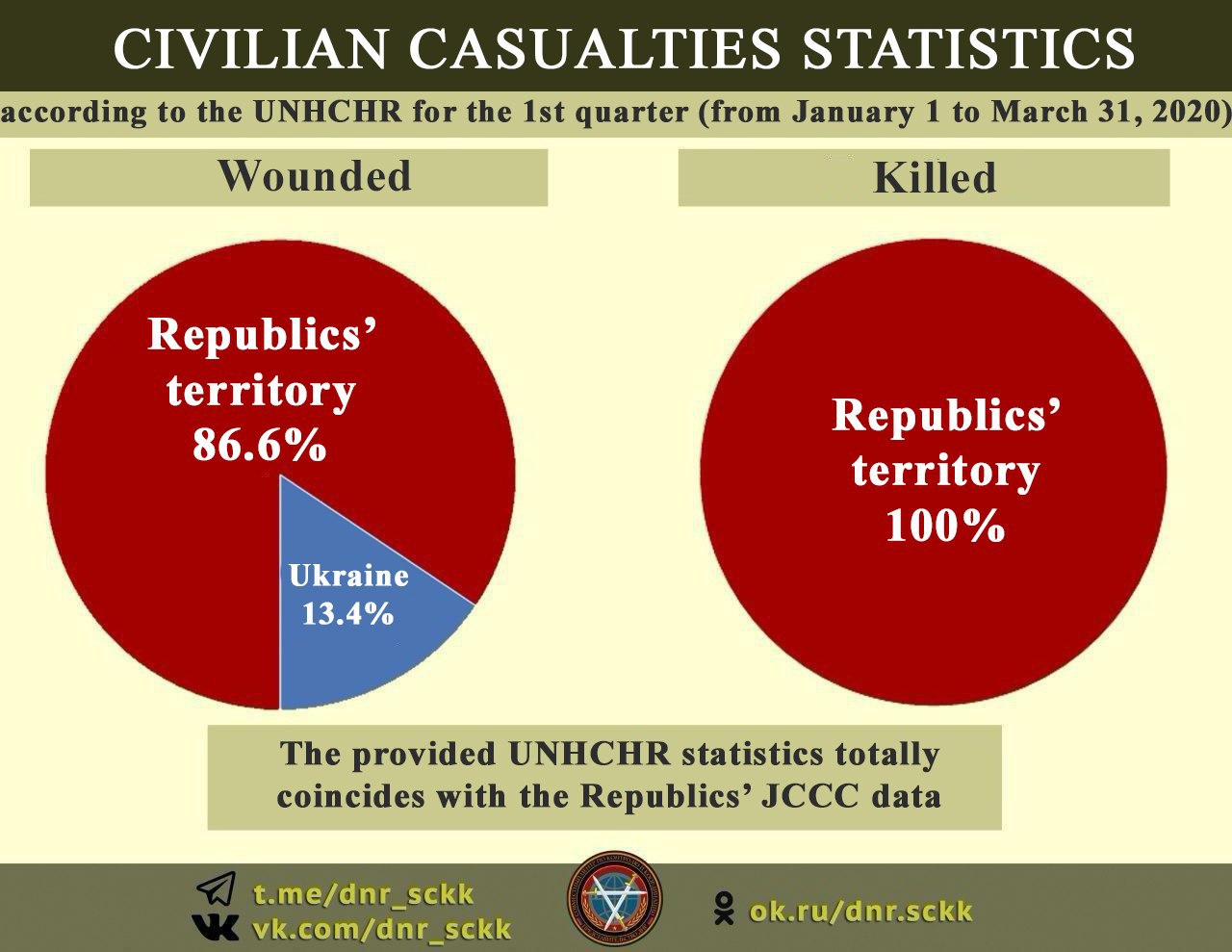Despite Kiev officials’ ambitious statements on their strife for peace, the need for another ceasefire in view of the COVID-19 virus spread and their willingness to put an end to hostilities in Donbass, enemy forces keep shelling the territory of the Donetsk and Lugansk People’s Republics.
Military aggression by the AFU continues to escalate, which results in casualties and injury among civilians.
Thus, according to the Republics’ JCCC, two civilians got killed and 14 were wounded in the DPR, and five were wounded in the LPR by shelling by Ukraine’s armed formations for the period from January 1 to March 31, 2020 (the first quarter).
A total of two perished and 19 wounded civilians were registered in the Republics for the first quarter of 2020.

At that, we draw attention to the fact that, despite the lowest rates of casualties caused by shelling for the entire armed conflict period registered in January and February 2020, the number of civilian deaths due to shelling of the Republics’ territories by the AFU heavily increased in March.
That is, most cases of civilian casualties in the DPR territory in the first quarter of 2020 occurred in March: 11 wounded and two killed civilians (in the LPR there were no such losses in March).
The Republics’ JCCC documents all the ceasefire violation effects, including those that resulted in civilian losses. The collected data was recently confirmed in the report of the Office of the United Nations High Commissioner for Human Rights (abbreviated to UNHCHR) dated April 7, 2020.
In particular, there was provided statistics on civilian casualties caused by shelling for March 2020, which fully coincides with the data of the Republics’ JCCC: 11 wounded and two killed in the DPR territory.

At that, the report notes that in January and February 2020 almost every victim was registered in the LPR territory, and in March the vast majority of affected persons were registered in the DPR territory.
Whereas only three wounded civilians were registered in the AFU-controlled territory for the first quarter of 2020.
Thus, civilian losses for the first quarter of 2020 in percentage terms amounted to:
86.4% out of the 100% wounded civilians were registered in the Republics’ territory and 13.6% — in the Ukraine-controlled territory.
100% out of the 100% deaths occurred exclusively in the territory of the Donetsk People’s Republic.

Unfortunately, an entirely different situation with registering ceasefire violation effects that resulted in civilian casualties emerges in the activities of a special monitoring body, the OSCE SMM to Ukraine, which, in accordance with the Mandate, is required to record all the cases of civilians’ injuries and deaths.
Thus, for the first quarter of 2020, the OSCE SMM registered and recognised in its reports only 13 of 22 civilian casualties: 11 injuries (of which four in the DPR, five in the LPR, and two in Ukraine) and two deaths (in the DPR territory).
Therefore, in the first quarter of 2020, the Mission completed its direct task to register civilians affected by the armed conflict in Donbass by only 59%. It is worth noting that there is observed a stable trend.
The reasons for such a low percentage of the central facts of the armed conflict effects in Donbass, namely civilian casualties, documented and revealed to the global public, are of utmost concern, and therefore we request assistance from the Russian Federation representatives to the OSCE in eliminating this trend which is harmful to the OSCE image.
We likewise draw attention to the OSCE SMM’s non-compliance with the basic principles which it is bound to apply in its activities, namely, transparency and parity, when generating quarterly and other reports for certain periods.
Although Republic officials regularly address the OSCE SMM leadership with a request to separate the number of civilian casualties in their period reports by territory (as it is done with all other violation facts, for example, ceasefire violation effects, prohibited weapons, restriction of the Mission’s movement freedom), the SMM continues to provide generic data on the major indicator of any armed conflict, thereby blurring the true picture of the consequences of the parties’ violating the existing peace treaties when it comes to safeguarding people’s lives.
I would also like to draw attention to the disturbing priority in reporting information on various categories of violations by the parties in the OSCE SMM period reports: as the report for the first quarter of 2020 shows, of the four blocks of various categories of violations by the parties, the most important one — civilian casualties — is the most statistically unreliable, and the general statistics provided in the report’s heading contains no such category at all.
In view with the foregoing, we once again publicly urge the OSCE SMM leadership to bring its format of reporting to the global public into line with the basic principles of the OSCE, as well as to step up the implementation of their direct responsibilities — to register and reveal to the world community as much data on civilian casualties as possible.
We are hopeful that the OSCE Mission will find resources to document the effects of war crimes more thoroughly, and the data provided in the UNHCHR report will form the basis for the standing of the countries guaranteeing the Minsk Agreements’ implementation by the Ukrainian party.
We are convinced that the affirmative actions of international organizations and world leaders of the Minsk Agreements guarantor countries alone can force official Kiev to comply with its obligations to respect the ceasefire and additional measures to enhance and control it in order to prevent the death and injury of Donbass residents.





